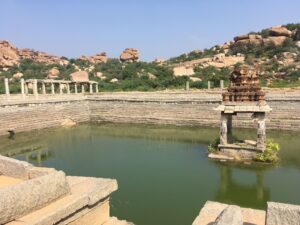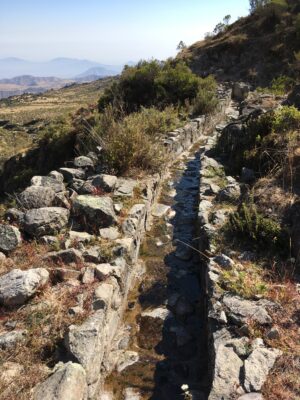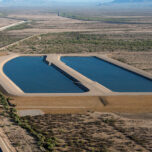August 4, 2022 — Editor’s note: This is an edited excerpt from Water Always Wins: Thriving in an Age of Drought and Deluge by Erica Gies, copyright © University of Chicago Press, 2022. Learn more at slowwater.world. While most of Ensia’s content is available under Creative Commons, this story is excluded.
Epic flooding has killed hundreds of people across Pakistan, India, South Africa, Germany, New York, Kentucky and British Columbia, Canada, in the last year. Intense droughts are parching landscapes and wilting crops across Texas, the U.S. West and the Horn of Africa. As these water extremes hit more and more people where they live, there’s a growing awareness that climate change is water change.
People usually respond to these disasters by calling for higher levees, bigger drains and longer aqueducts. But such interventions are increasingly failing. As we grapple with climate extremes, a hard truth is emerging: Our development choices — urban sprawl, industrial agriculture and even the concrete infrastructure designed to control water — are actually exacerbating our problems and raising the stakes for failure. Because sooner or later, water always wins.
The dominant culture views water as either a commodity or a threat, which is why we seek to control it. But the way we relate to water is not inevitable.
Today, “water detectives” — ghost-stream hunters, ecologists, biologists, landscape architects, urban planners, environmental engineers — around the world are instead working from a philosophy rooted in curiosity, respect and humility, rather than a too-common arrogance. They start with a radical question: “What does water want?”
To find out, the detectives are uncovering what water did before generations of humans so radically transformed our landscape and waterways. How did water interact with local rocks and soils, ecosystems and climates before we scrambled them? With their discoveries, we begin to understand why certain areas flood repeatedly, or how our tendency to speed water off the land deprives us of urgently needed local rainfall that — if allowed to move underground — could supply streams in summer. Then we begin to think creatively about how we can solve these problems by making space for water within our human habitat.

Temple tanks such as this one in Hampi, Karnataka state, are part of a once-extensive eris system (a Tamil word for tanks) across South India that captured monsoon rains, slowing water and moving it underground to keep water available throughout the dry season. Photo © Erica Gies. Click image to expand
So what does water want? Many modern humans have forgotten that water’s true nature is to flex with the rhythms of the Earth, expanding and retreating in an eternal dance upon the land. In its liquid state, with sufficient quantity or gravity, water can rush across the land in torrential rivers or tumble in awe-inspiring waterfalls. But it is also inclined to linger to a degree that would shock most of us because our conventional infrastructure has erased so many of its slow phases, instead confining water and speeding it away. Slow stages are particularly prone to our disturbance because they tend to be in the flatter places — once floodplains and wetlands — where we like to settle.
But when water stalls on land, that’s when the magic happens, cycling water underground and providing habitat and food for many forms of life, including us. The key to greater resilience, say the water detectives, is to find ways to let water be water. They all aim to slow water on land in some approximation of natural patterns. For that reason, I’ve come to think of this movement as “Slow Water.”
Like the Slow Food movement founded in Italy in the late 20th century in opposition to fast food and all its ills, Slow Water approaches are unique to each place: They work with local landscapes, climates and cultures rather than try to control or change them. Slow Water seeks to call out the ways in which speeding water off the land causes problems. Its goal is to restore natural slow phases to support local water availability, flood control, carbon storage and myriad forms of life.

A 1,400-year-old technique called amunas (Quechua for “to retain”) funnels high flows in the wet season to natural infiltration basins. Water then seeps underground, moving slowly down the mountain. Communal farmers harvest the water from springs in the dry season to water their crops. That water then moves underground again, ultimately extending water availability for downstream cities such as Lima. Photo © Erica Gies. Click image to expand.
Some people say that Slow Water approaches can’t cope with today’s water extremes. But it’s a question of scale. The majority of projects to date are miniscule: a little vegetated ditch to absorb some stormwater runoff, or a small stretch of creek brought to the surface from an underground pipe. Those tiny interventions can’t counteract the degree to which we’ve altered the natural water cycle. We’ve built or planted upon 87 percent of the world’s wetlands. We have intervened on two-thirds of the world’s great rivers. The paved areas of our cities have doubled just since 1992, causing a sharp rise in urban flooding and water scarcity in cities.
To repair the global water cycle and reduce our risk from flood and drought, we need to return many small areas for water to stall throughout a region. It’s akin to how solar on many roofs can add up to a lot of electricity.
And just as Slow Food is local, supporting local farmers and thereby protecting a region’s rural land from industrial development and reducing food’s shipping miles and carbon footprint, ideally, Slow Water is too. The engineered response to scarcity has been to bring in more water from somewhere else. But desalinating water or transporting it long distances consumes a lot of energy. Moving water is also an environmental justice issue. Over a 40-year period, interventions on big rivers, including dams, brought more water to 20% of the world’s people — while taking it from 24%.
Ultimately, big water transfers can harm the receivers, too. When we live long distances from our water, we don’t understand the limits of that supply, so we’re less likely to conserve. Bringing in water from somewhere else encourages overexpansion of human population and activities where there isn’t enough local water. It’s similar to when a city builds extra lanes to reduce traffic, which then attracts more cars, causing gridlock again. In places such as in the U.S. Southwest, Southern California or the Middle East, we have made people and activities vulnerable to the water cycle, rather than resilient.
Today’s dominant culture is rooted in an ideology of human supremacy: Humans’ needs and wants — particularly privileged humans — are considered more important than nature’s right to exist.
Slow Water’s philosophical embrace of collaboration finds a guiding perspective from cultures around the world that remain more connected to nature. Kelsey Leonard is a Shinnecock citizen and assistant professor in the School of Environment, Resources, and Sustainability at the University of Waterloo in Ontario. As she explained to me and an audience of river researchers in an online talk in 2020, many Indigenous traditions don’t consider water to be a “what”— a commodity — but a “who.” They not only believe that water is alive, but that it’s kin. “That type of orientation transforms the way in which we make decisions about how we might protect water,” she said. “Protect it in the way that you would protect your grandmother, your mother, your sister, your aunties.”
In contrast, today’s dominant culture is rooted in an ideology of human supremacy: Humans’ needs and wants — particularly privileged humans — are considered more important than nature’s right to exist. But this us-first stance hasn’t done humanity any favors. By focusing on single-minded problem-solving to service human needs, we ignore interconnected entities in the systems we change, causing myriad unintended consequences, from climate change to the extinction of other species to water woes.
The water detectives are a diverse bunch and don’t all hold these beliefs. But they share an openness to moving from a control mindset to one of respect. Admitting that water always wins is not weakness. Instead, it’s the foundation for strength because it opens us up to innovative solutions. At a time when climate change can feel overwhelming because nations are failing to reduce emissions, Slow Water projects empower people to take action in their own communities. By working with water, we can protect ourselves from water extremes, help to slow climate change by storing carbon in wetlands and forests, and enjoy the myriad benefits that cooperation can bring.
Related Posts
Ensia shares solutions-focused stories free of charge through our online magazine and partner media. That means audiences around the world have ready access to stories that can — and do — help them shape a better future. If you value our work, please show your support today.
Yes, I'll support Ensia!



